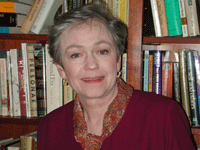| The Third Culture |
|
|||||||
|
|
People
learn from stories in a different way from the way they learn from generalities.
When I'm writing I often start out with abstractions and academic jargon,
and purge it. The red pencil goes through page after page, while I try
to make sure that the stories and examples remain to carry the kernel
of the ideas, and in the process the ideas become more nuanced, less
cut and dried. Sometimes reviewers seem to want the abstractions back,
but I figure that if they were able to recognize what's being said,
it didn't have to be spelled out or dressed up in pretentious technical
language.
CROSSING
CULTURES [10.12.00]
Introduction "I think of my daughter and myself as having been born in different countries," says cultural anthropologist Mary Catherine Bateson. "We were actually born 30 years apart in the United States of America. That means we were born into massively different cultural environments. What occurred to me, and this is something I've felt for a very long time ‹ is that you can use what people learn in the home, especially from age differences, to deal with other kinds of diversity. After all, we learn more at home before we get to school than we learn in school. And we learn about the nature of learning, fundamental things about relationships, so that we need to be more systematic in using learning within the home for the insight it offers to understanding things outside the home. Including learning to learn, of course." Bateson asks us to "notice what it takes to communicate effectively across that generational gap. And then to realize that unfamiliar groups are different in the same kinds of ways, that you know how to bridge the gap, so that there's no need to be put off by the sense of strangeness ‹ you can learn how to deal with strangeness in the home." Sociologist Sara Lawrence-Lightfoot has made note of Bateson's "unique signature: Her uncanny ability to find the strange in the familiar, the ordinary in the exotic." In this regard, Bateson is rather unique among the third culture scientists on these pages as her particular writing style itself is key to an understanding of her work and ideas. "What I always wonder about with my writing," she says, "is whether people will be able to move from the specific, rather personal stories that I bring together to the general issues that I believe they represent. I need people to be able to move from the women in my new book Full Circles, most of whom are African-American, to the situation of men as well as women, people of all ethnic groups, people outside the United States who also live in a time of rapid change and increasing longevity. It's that capacity to apply analogies that some people seem to have while others don't." Bateson purges abstractions from her books and makes way for stories, sometimes of people whose lives you might not think would be of interest to you, and allows those stories to carry the kernel of the ideas. "And in the process" she says, "the ideas become more nuanced, less cut and dried." Given this context, I decided that one way to approach her work was to talk to her about her own story. – JB MARY CATHERINE BATESON is Clarence Robinson Professor of Anthropology and English at George Mason University in Fairfax, Virginia. Her books include With a Daughter's Eye (on her parents Margaret Mead and Gregory Bateson); Our Own Metaphor; Angels Fear: Toward an Epistemology of the Sacred (written with Gregory Bateson); Composing a Life; Peripheral Visions: Learning Along The Way; and, most recently, Full Circles, Overlapping Lives : Culture and Generation in Transition. See also the revised edition of Steps to an Ecology of Mind: Collected Essays in Anthropology, Psychiatry, Evolution, and Epistemology. CROSSING
CULTURES BATESON: What I always wonder about with my writing is whether people will be able to move from the specific, rather personal stories that I bring together to the general issues that I believe they represent. I need people to be able to move from the women in my new book Full Circles, most of whom are African-American, to the situation of men as well as women, people of all ethnic groups, people outside the United States who also live in a time of rapid change and increasing longevity. It's that capacity to apply analogies that some people seem to have while others don't.
|
